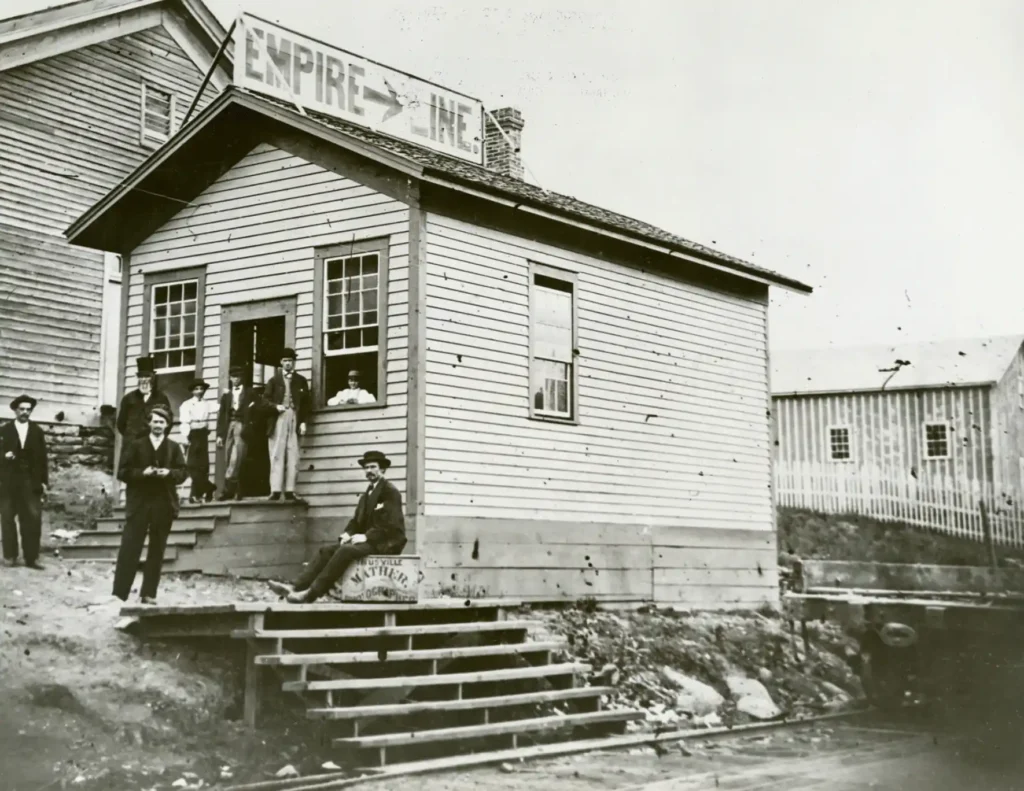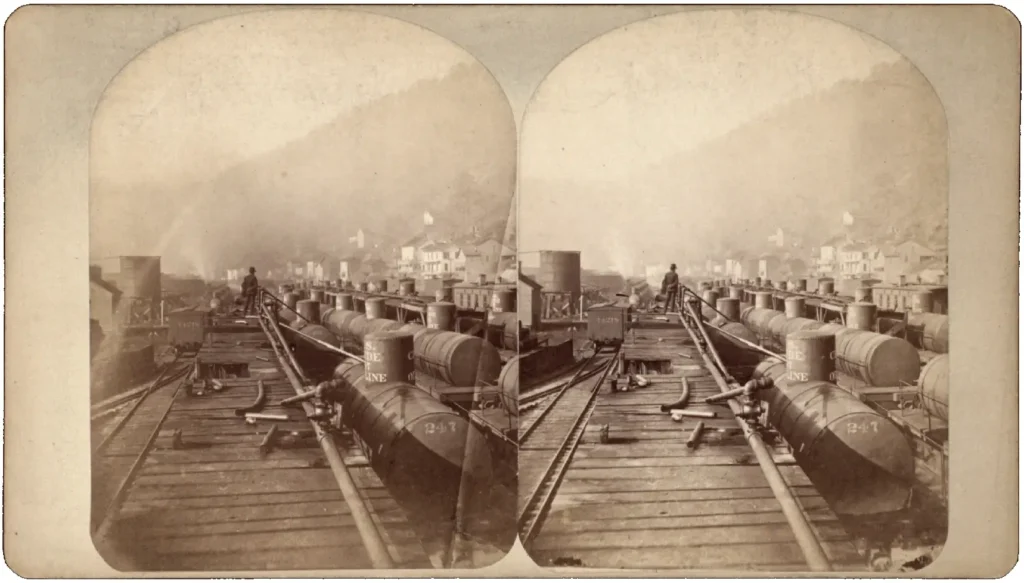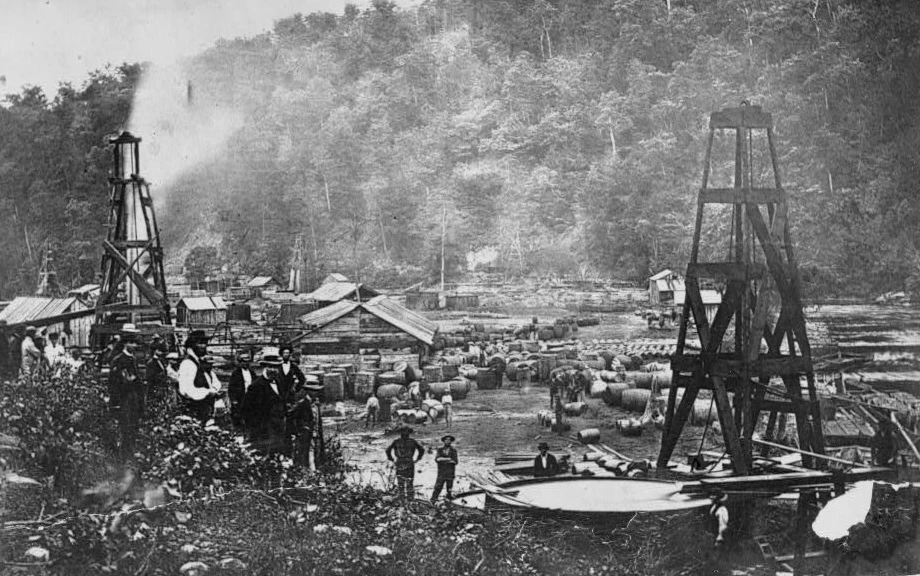Note: Today’s article is an abridged version of the original.
Tidioute, Tionesta, & Franklin News
Persons and Things in General, The Culver Case, Oil Production
Morning Herald (Titusville, Pa.), February 4, 1867

Editorial Correspondence
Franklin, Jan. 30, 1867
A sleigh-ride from Titusville to Tionesta — if there is plenty of snow, and if you have a light, jumping cutter, and a horse that needs no whip or driver’s exhortation — is, at least, a good deal more agreeable than being blown from the poop-deck of the Fleetwing in the middle of the sea. To be sure, it would detract somewhat from the enjoyment of the traveler if in freezing temperatures, he has boots that won’t hide his toes and no crown to his hat. We met several wayfarers trudging along on foot in this exposed condition and congratulated ourselves on furs and robes that turned the keen edge of the driving winds.
It is an up-and-down-hill journey, but there is a variety in the landscape — wood and stream — that never tires the beholder. There is much of the intervening country that is rich in lumber and oceans of oil, but where to strike, that is the question. There have been many failures, as you may see by the abandoned derricks and engine houses that dot the face of the country along the creeks and ravines. But also many successes and prodigious ones, as you may witness at Triumph City, three-quarters of a mile from Tidioute, up Dennis Run. Here is a forest of derricks. One of those extemporized settlements that convert a wilderness into a town “in less than no time.”
Tidioute
Your course lies down this prolific run — Dennis — to its mouth in the Allegheny, at which Tidioute is situated, stretching up the bank of the river two or three miles, lying on a single street.

The new road of the Warren & Franklin Railway, finished last August, with two daily trains stopping and passing daily up to Irvingtown and down to Oil City. Mr. Peelor, the contractor and efficient agent of the Company at this point, informs me that from 1,800 to 2,000 barrels of oil a day are shipped from Tidioute mostly by tanks on the Empire Line.
Tidioute has a population of about three thousand. Its principal trade is merchandising. It has three refineries. Haight, Archer & Co., and Olmstead & Jewhurst, of your city, have brick stores here — the largest and most flourishing in the place, I hear. The headquarters of the Titusville delegation is the Thomas House, decidedly the best hotel in the place, they all say. I certainly ask no better entertainment than is there provided by the liberal landlord and his attentive assistants.
I saw many familiar Titusville faces here — among others, Messrs. Temple, Bergam and Bunting, shippers. Mr. Bunting has an office and platform along the river and railroad and tanks on the hill, which are fed by underground pipes from the wells up the run. The political “pot is boiling” and the approaching borough election will bring out all the strength of the young America and the old fogy elements. And I might mention, too, that I called on the ubiquitous and merry Colonel Henry McKenty, the man who swaps Western lands for oil interests. If you want a “trade,” he is your man. He has maps and surveys and the chain of title. If you have got a farm, a well or “a hole going down” near one, he is ready to strike a bargain with you “in a jiffy.”

Tionesta
As I took my seat in the [railroad] cars on the river side, I soon forgot Tidioute and amused my imagination with the rising glories of the new county seat, Tionesta, at the mouth of Tionesta Creek and on the east bank of the Allegheny River. The train stopped on the opposite shore at the station where there is also a large and good view of it. I counted the houses, almost forty in all, and all in a line. This place, like Tidioute, has no back street, only a view frontage, until you get “downtown.”
In this respect, it is unfortunately very dissimilar from Reno, whose natural advantages as a river town, with an easy slope to the hill beyond, are very striking. While I saw no brick buildings in the place, neither were there any paste-board shanties. The few stores and shops looked very respectable. The houses were all painted and some of them genteel. I suppose the corner lots are all “in first hands” yet.
The lawyers, editors and aspiring politicians of the capital are “playing euchre in the barroom” till the new county and the new county seat are made “fixed facts” by the powers that be. The city seemed like Titusville on Sunday, the inhabitants being, I suppose, mostly at Harrisburg to convince the Legislature that it is “all right.” The townships set off from Venango, and most directly affected, mutter curses loud and deep against going to court to Tionesta. But enough of politics.

Franklin
It was almost midnight when I reached Franklin. It’s a pity that the depot here and the hotels don’t make closer connections. It is worth a long walk to get to the nearest one and the best one — the Exchange Hotel. Mr. Burns, proprietor, also keeps the Jones House at Oil City with Mr. Tiffany.
The Culver Trial
The reading rooms and halls and parlors are alive with gents from all quarters, for this is court week. The noted Culver trial is to come off, with a distinguished array of counsel pro and con. The case is the absorbing topic of conversation. Forensic contest will be conducted with great vigor and acumen on both sides. A preliminary argument will be made this evening on the question whether the federal, rather than the state courts should try these indictments. If it be decided that the state courts have jurisdiction in matters growing out of National Bank matters, the trial will probably proceed on Friday next.
Oil Production
In conclusion, let me give your readers the estimated production of the Pennsylvania oil regions. (It has been furnished me by an oil buyer by way of an oil producer, who claims that the production is only one half as much.)
| Location | Barrels |
|---|---|
| From Oil City to Tarr Farm, including Cherry Run | 550 |
| Tarr Farm | 450 |
| Story Farm | 525 |
| Central Petroleum Company | 1,800 |
| Stevenson and Bennehoff | 1,000 |
| Near Boyd Farm | 100 |
| Pioneer and McElhenny | 800 |
| Bull and Cow Run, etc. | 500 |
| Pithole and West Pithole | 700 |
| Dennis Run and tributaries, Gordon, Dingle, etc. | 2,000 |
| Allegheny River, including Foster Farm | 700 |
| Hyde and Egbert Farms | 400 |
| Church Run | 200 |
| Total | ~9,200 |
It is highly probable that Pioneer, at present, is not yielding half of what is claimed for her in the above table, nor the Stevenson and Bennehoff territory more than two-thirds as much as she is here allowed. Same with the Tarr Farm. The production of Dennis Run is also exaggerated. Comparing notes, I am inclined to think that the whole present yield will fall short of 8,000 barrels a day. Possibly 7,000. I merely present the table to afford an opportunity for the correction of any errors that may appear in it.
More anon.
H. C. B.
